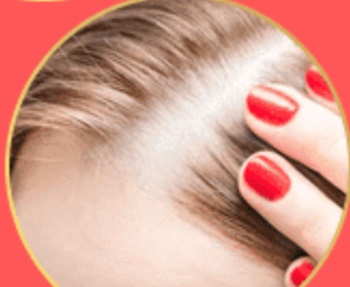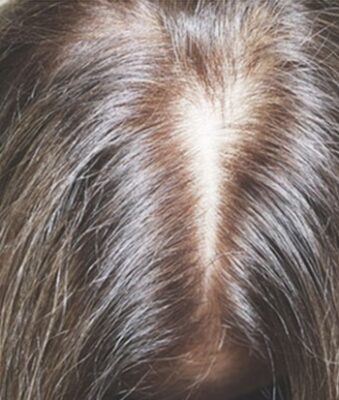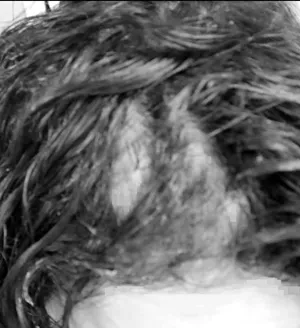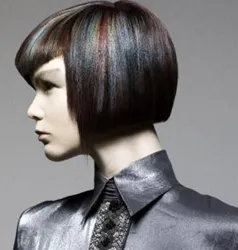
Can Women Have Invisible Hair Loss?
 Woman Struggling With Invisible Hair Loss
Woman Struggling With Invisible Hair LossDid you know you can lose 50% of your hair without knowing it? Seriously? Yes indeed.
Invisible Hair Loss also referred to as Invisible Baldness, means that a woman can lose as much as 50% of their hair without realizing that they are experiencing any type of hair thinning.
Is that frightening? Yes, because you don't even know you've lost a lot of hair until one day, you see a sliver of your scalp shining through in the mirror.
How To Know If You're Suffering From Invisible Female Hair Loss?
There are several ways to know if you're suffering from invisible hair loss.
Consider the following signs:
1. Your hairstylist gently (or maybe not as gently as you'd like) asks if something is happening in your life that is causing excessive hair shedding.
2. Even if your hairstylist is too polite to say anything about your hair, a haircut may open your eyes. After a fresh haircut or trim, you may notice your hair doesn't seem as thick as normal. Or you see the usual density on certain parts of your scalp is different.
 Thinning Hair Part On A Female
Thinning Hair Part On A Female3. Have you had your roots touched up? Or have you added highlights and lowlights? Is the usual feeling of more volume after adding color missing.
4. Your hair texture feels different. If your hair was previously coarse but suddenly feels softer to the touch, you may be experiencing hidden hair loss or accelerated shedding. Maybe your hair feels less heavy than usual. Or your natural waves, curls, or kinks seem less defined or springy.
5. Your ponytail is shrinking. Your regular braid, ponytail, or bun feels lighter or thinner. There is less hair to braid, put up in a pony, or wrap into your regular top knot.
6. If your hair looks lackluster? It may look dull, drab, or limp. Diminishing hair volume and fullness is a sign. You may find your hair changing if you stop coloring or highlighting/lowlighting it.
7. You're going through some sort of hormonal disruption, including but not limited to menopause. Perimenopause, menopause, or post-menopause may be triggering. Starting or stopping high androgen birth control can trigger hair loss. So can pregnancy or post-pregnancy.
 Diffuse Hair Loss Along The Top Of The Head - Hidden Female Hair Loss
Diffuse Hair Loss Along The Top Of The Head - Hidden Female Hair Loss8. Someone or several someones in your family gene pool, including women, have had progressive hair loss conditions.
9. You may have ignored it, but you've had more hair shedding. More hair shows up on your pillow or in your brush. Or you see lots of hair in the shower drain.
10. You have aged. Senescent alopecia may occur with aging. Scientists can't agree. If you're over 70, you may have this rare condition.
A Female Celebrity Case Of Invisible Hair Loss
Dirty Dancing star Jennifer Grey recently discussed her own hair loss struggles with the media. Grey told Prevention Magazine that she first noticed a change in her hair during Covid. She initially struggled with her own questions about invisible hair loss.
She explained, "I didn't know what to attribute it (the hair change) to. Was it because I wasn't cutting my hair, I wasn't going to salons, or because I wasn't coloring my hair?"
The 62-year-old actress didn't know what was going on with her hair. She did notice "her ponytail was getting skinnier and her hair was looking a little bit lackluster." The change from her usual "voluminous curls" was subtle, but Grey knew something about her hair was different.
 Jennifer Grey - 2014 - DC Media
Jennifer Grey - 2014 - DC MediaUltimately she got confirmation that her hair was thinning, and she took steps to address it. She experienced invisible hair loss. It took time for her to finally figure out what was happening.
Avoid Depending Upon The Mirror Hair Loss Test
A common mistake women make with detecting hair loss is to rely on the "mirror test" before taking action.
Unfortunately, most women wait until their hair loss becomes readily noticeable. It could be diffuse thinning throughout the part, on top, or a slowly receding hairline.
Relying only on the mirror visual cues puts you at a disadvantage. Why? Because by the time hair loss is visible, half of your hair in that area may already be gone.
What To Do When You Discover You Have Invisible Hair Loss?
If you do discover that you've been suffering from invisible hair loss, what should you do?
1. Don't waste another minute.
 Hairloss Along Hairline Edges - Hair Loss SBHB
Hairloss Along Hairline Edges - Hair Loss SBHBFind a hair loss specialist who can do all the necessary hair loss diagnostic tests. Whether this means a dermatologist specializing in hair loss or a hair loss restoration surgeon, it's critical to get an accurate baseline diagnostic.
Even if you can't find a dermatologist or hair loss restoration expert, you may be able to start with an endocrinologist who can run detailed blood tests.
Sometimes thyroid disease may be a trigger. An endocrinologist can definitely test for thyroid issues. An OB/GYN can also test to determine if hair loss is related to birth control.
Don't rest until you feel you have a true base diagnosis for your hair loss so that you can successfully treat it.
2. Embrace a treatment plan.
 Lab Tech With Microscope
Lab Tech With MicroscopeOnce you understand your base diagnosis, you can make informed decisions
Some cases of hair loss, such as Female Pattern Hair Loss (FPHL) as androgenic alopecia (AGA) or Alopecia Areata (AA), may not be curable. Many treatments can help to temporarily stall or stop the progression of hair loss.
In some cases, hair may be regrown, but not in all cases. This is true of Telogen Effluvium (TE), which may or may not be a temporary hair loss condition.
Summary
 Oral Hair Loss Medications
Oral Hair Loss MedicationsWomen aren't immune from “invisible hair loss.” A thinning ponytail or braid can be some of the first signs that a woman is losing her hair.
While there are many different hair loss triggers, it's critical to achieve a base diagnosis as quickly as possible.
Hair loss diagnostics have advanced significantly. Locating and working with the very best loss medical expert is a critical next step for any woman who discovers that they are indeed suffering from invisible hair loss.
Best wishes to all.Social Media Network Information
Please follow us on Twitter at: https://Twitter.com/HairBoutique. I look forward to meeting new people from all walks of Twitter and learning from their Tweets.















